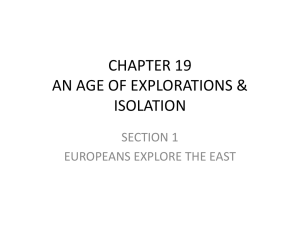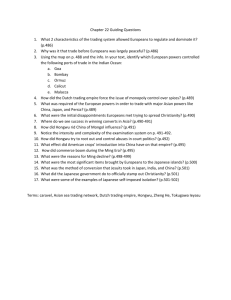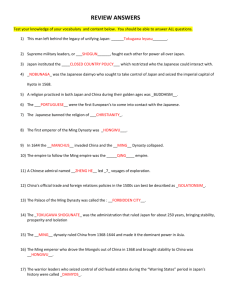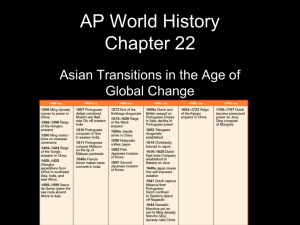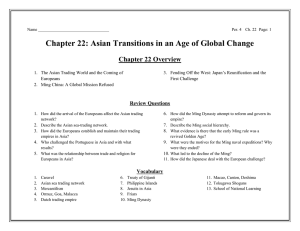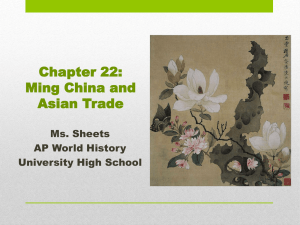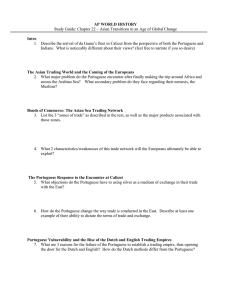Name: ________________________________ Date: _________________ Per: ____________
advertisement
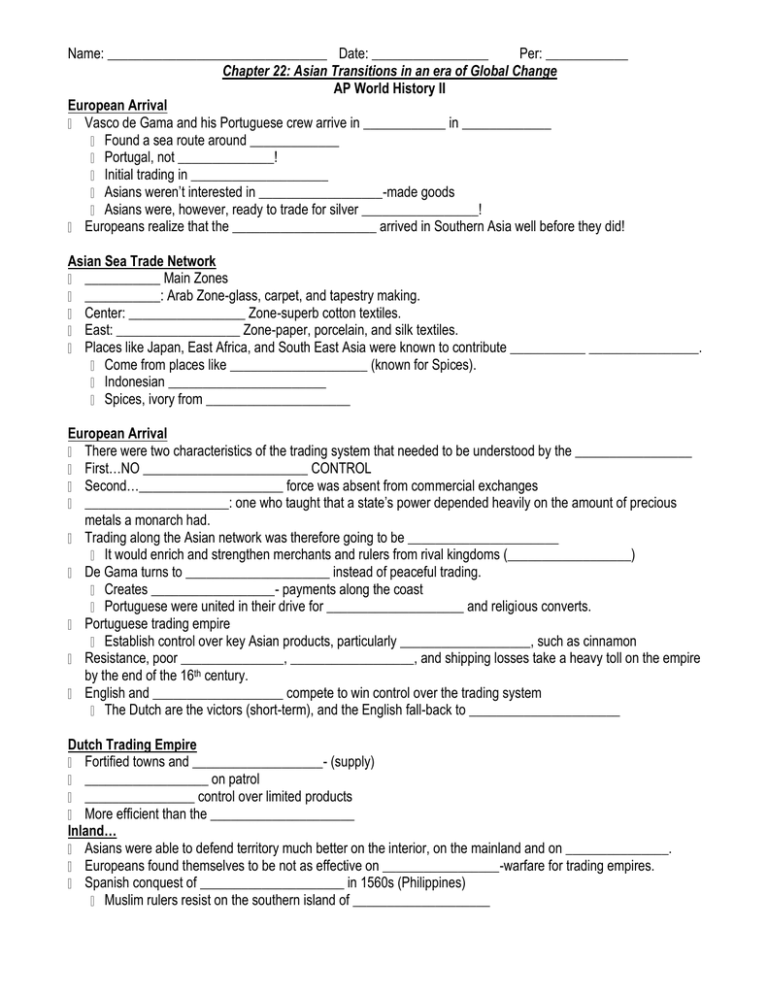
Name: ________________________________ Date: _________________ Per: ____________ Chapter 22: Asian Transitions in an era of Global Change AP World History II European Arrival Vasco de Gama and his Portuguese crew arrive in ____________ in _____________ Found a sea route around _____________ Portugal, not ______________! Initial trading in ____________________ Asians weren’t interested in __________________-made goods Asians were, however, ready to trade for silver _________________! Europeans realize that the _____________________ arrived in Southern Asia well before they did! Asian Sea Trade Network ___________ Main Zones ___________: Arab Zone-glass, carpet, and tapestry making. Center: _________________ Zone-superb cotton textiles. East: __________________ Zone-paper, porcelain, and silk textiles. Places like Japan, East Africa, and South East Asia were known to contribute ___________ ________________. Come from places like ____________________ (known for Spices). Indonesian _______________________ Spices, ivory from _____________________ European Arrival There were two characteristics of the trading system that needed to be understood by the _________________ First…NO ________________________ CONTROL Second…_____________________ force was absent from commercial exchanges _____________________: one who taught that a state’s power depended heavily on the amount of precious metals a monarch had. Trading along the Asian network was therefore going to be ______________________ It would enrich and strengthen merchants and rulers from rival kingdoms (__________________) De Gama turns to _____________________ instead of peaceful trading. Creates __________________- payments along the coast Portuguese were united in their drive for ____________________ and religious converts. Portuguese trading empire Establish control over key Asian products, particularly ___________________, such as cinnamon Resistance, poor _______________, __________________, and shipping losses take a heavy toll on the empire by the end of the 16th century. English and ___________________ compete to win control over the trading system The Dutch are the victors (short-term), and the English fall-back to ______________________ Dutch Trading Empire Fortified towns and ___________________- (supply) __________________ on patrol ________________ control over limited products More efficient than the _____________________ Inland… Asians were able to defend territory much better on the interior, on the mainland and on _______________. Europeans found themselves to be not as effective on _________________-warfare for trading empires. Spanish conquest of _____________________ in 1560s (Philippines) Muslim rulers resist on the southern island of ____________________ Spreadin’ the faith… Spread of __________ Catholicism was a major force in the Europeans thrust into the _________ trade network. Initial indifference and open __________________ India appeared to be one of the more promising fields for __________________. Some learn different _____________________ Adopted ___________________ diets Aimed at converting upper-__________ _________, who would then set the example for lower-class (untouchables, etc.) Conversion Conversion only occurred in __________________ areas Somewhat successful on the Northern islands of the ____________________. Friars built new settlements with town ____________________ where the church was located. Represents a mix of Christian and _________________ ways China and the Ming Dynasty Restoration of ethnic Chinese rule under the ________________ Dynasty (1368-1644) Largest _____________ of any civilization of the time Renewed ________________-/_________________ growth Europeans use New World ______________ to pay for goods High degree of ___________________ Large numbers of skilled __________________- and artisans Centralized __________________ China and the Ming Dynasty-Hongwu Zhu Yuanzhang declares himself the ___________________ Emperor First Ming _____________________ Hongwu=“Vast ___________________” Wants to rid China of all traces of the “____________________” ___________________ Mongol _______________ was discarded Mongol ______________ were dropped Mongol palaces were ______________________ Return of the ___________________-Gentry Somewhat suspicious of this class because of his _________________ upbringings Scholars versed in __________________ classics were appointed to high positions in government ______________________________________ system was reinstated Abolished the position of chief __________________ Instituted Public _______________ for bureaucrats found guilty of _____________ and incompetence Hongwu tries to cut down on factionalism and _________________ that eroded power from earlier Dynasties Exiled all potential rivals to the throne to estates in the _____________________ Forbade them to be involved in _____________________ affairs Thought control-deleted sections of __________________ writings Introduced measures to improve lives of _______________________ ___________________ works projects Unoccupied land would become the tax-exempt property of those who _____________ and ______________ it China and the Ming Dynasty Women: ______________________ to men as per Confucianism. Played role in Hongwu’s __________________ Hundreds/Thousands of women would wait at the palace to be seen by the emperor as one of his ________________ Status was defined as to their ability to bear ____________________ children Ming China Territory controlled was not as _________________________ as in the T’ang Dynasty Commercial and ______________________ boom began in the ____________ Dynasty was continued Spanish and Portuguese _____________ contacts imports _________________ from the New World From the ______________ highlands ___________________, sweet potatoes, peanuts Grown on inferior soil with little _______________________ Cultivation spread quickly through _____________________ areas Food crop importation is key to hedging famine amongst HUGE _______________________ growth Commercial growth: Advanced handicraft _____________________ _____________ textiles ____________ Fine __________________ Balance of trade was VERY MUCH in _______________________ favor Arab, Asian, and now European traders arrive at ______________ and __________________ These are the only two places where _________________ were allowed to do business in Ming China Merchants make lots of money in this trade _____________________ paid to scholar-gentry (bribes, too) Merchants invested more in _____________________ Ming prosperity was reflected in the fine ____________________ Development of Chinese ________________________ (the Novel) Between 1405 and 1423 China launched a series of impressive ____________________- at Sea During ___________________ reign Went to Southeast Asian kingdoms, _________________, southern Arabia, East Africa ___________________ expeditions __________ ships (4 for De Gama, 3 for Columbus) 28,000 sailors, ________________, soldiers __________________ foot long ships China had the capacity to expand at least a century before the Europeans rounded the __________________. After 1400, China aims to LIMIT China’s overseas _________________________ Ming war fleet dramatically _____________________ As the Chinese shut themselves in, the Europeans were irresistibly drawn to the Middle Kingdom for __________. Some scholars show interest in __________________, but never took a real hold on the court, or the people. Ming China-Decline Highly centralized, ___________________ structure developed by Hongwu and continued by Yunglo could not be continued. Official _____________________ Isolation of ________________ rulers Public works projects fall into ____________________. Floods, droughts, ___________________ afflict the land Increased foreign threats, mostly by the _________________ The last emperor of the Ming, __________________, commits suicide as the walls of the Forbidden City are scaled by rebels…the Dynasty ends in 1644. Japan Kamakura Shogunate: 1185-1333, establishment of the ________________ under Minamoto no Yoritomo Ashikaga Shogunate: 1336-1573, weaker with most of the power lying in the hands of regional _____________ By 1500’s, continual ______________ war amongst the Daimyo Three able-military leaders were needed to restore __________________ and order Oda Nobunaga used ______________________ that Japan had gained from the Portuguese in the 1540s. Deposed the last of the Ashikaga Shoguns in ___________________ By 1580 he puts most of ___________________ island under his command Killed in 1582 Toyotomi Hideyoshi (one of Nobunaga’s Generals) moved to ______________ those who betrayed Nobunaga and renewed the drive to break the power from the Daimyo. Ruled most of Japan by ____________________ Launched two attacks on _________________ in 1592 and 1597 with almost 150,000 soldiers No real success… Dies in ____________________ Tokugawa Ieyasu concentrates on ______________________ power at home. By 1603 he was granted power as Shogun by the __________________Beginning of the ________________________________________ Ends civil wars, brought the semblance of political unity to the __________________ Rules from ___________________ (later to be, Tokyo) The Tokugawa Shogunate _______________________ had increasing contact with the Japanese throughout the warring period Brought goods traded in _________________, China, and SE Asia Exchanged for _____________________, copper, pottery, etc. Traders and missionaries brought ____________, printing presses, and other western devices, like clocks Contacts with Europeans changed warfare (guns), and led to increased ________________________ contacts with China, Korea, Philippines, and Siam Conversion (before Tokugawa) Jesuits employ the top-down model of impressing the _____________ (in this case, Nobunaga in the 1570s) Convert many of the ______________________ Nobunaga himself was said to be at the verge of ______________________-. Hundreds of thousands of converts by the early ___________________ Hideyoshi though, was ______________________ of the Europeans, and saw the writing on the wall… Commercial and Military ventures first…then _____________________ the islands Conversion is cut short in the ___________________ Tokugawa Isolationism Beginning in the 1580’s, amid skepticism about the intentions of the Europeans official measures are taken to _____________________ foreign activities in Japan. Christian ________________________ are ordered off the islands by Hideyoshi Ieyasu continues the persecution and bans _________________________ by 1614. ______________________________ are hunted, killed, or expelled. Japanese Christians were required to renounce their ____________________, or face imprisonment, torture and execution. 1630: All Japanese ships were _______________________ to trade, or even sail overseas 1640s: Only a limited number of ______________ and Chinese chips were allowed to trade on the island of _______________________, in Nagasaki Bay. ______________________ export was restricted Western ______________________ banned Foreigners were permitted to live and travel only to VERY ______________________ areas. By the 1650s total ______________________________ was almost complete. Emphasis on _______________________ unique historical experience
